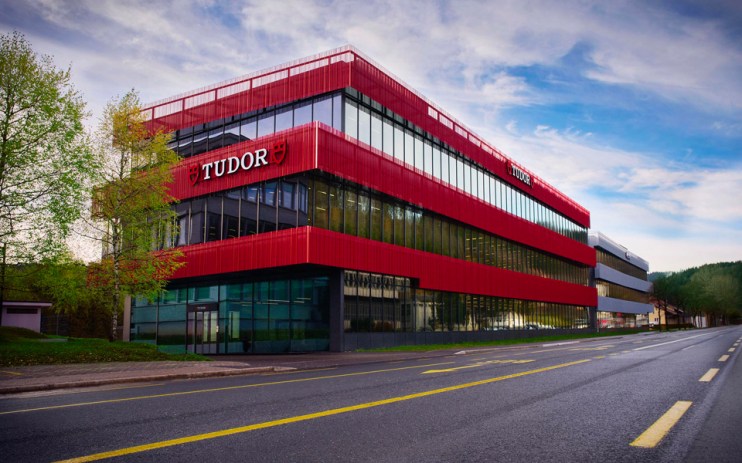Tudor’s new Jura Mountains facility places it at the bleeding edge of watchmaking

There’s a valley in the Swiss Jura mountains, bordering France, fondly known as ‘Watch Valley’. At the easternmost end you’ll find the gridded Art Nouveau streets of La Chaux-de-Fonds, Europe’s highest city and home to Breitling, Girard-Perregaux, Cartier et al. Drive southwest to equally sleepy Le Locle at the other end and you’ll find Zenith, Tissot, Ulysse Nardin… plus new neighbour Tudor, whose building is kitted out in fire-engine red.
Completed in 2021 with four storeys totalling 5,500 square meters, it represents nothing less than the cutting edge in manufacturing mechanical wristwatches (still, ironically enough, working on principles coined in the 18th century).
It adjoins ‘Kenissi Manufacture’, Tudor’s mechanical-movement production facility, shared, believe it or not, with Chanel.
Other than “RED!”, the first thing to strike any self-respecting watch nerd will be, “how has it taken Tudor so long?” Surely with the vintage-flecked sports brand’s stratospheric rise in recent years, the mighty clout of its sibling (a certain Rolex) would guarantee an instant root-down in the ticking heartland of watchmaking?
The goal is to ‘verticalise’: watch-speak for mastering the industry’s 30-odd, impossibly precise, unforgiving processes under a single roof. This lofty aspiration is not simply to score bragging rights (there are far-more efficient marketing tactics than spending the tens of millions of francs required to tool-up and train-up) – it’s about independence.
Since the de-monopolisation of the Swatch Group’s white-label mechanical movement supply (the things that power millions of wrist-watches across the world) was first threatened over 20 years ago, horology firms have sought to control their own supply chains. And yes, it really has taken this long for the likes of Baume & Mercier, Oris, TAG Heuer and now Tudor to ‘relearn’ their own craft after years of relying on Swatch and its suite of off-the-shelf mechanics.
There’s also been a shift in how the 100-plus components of a mechanical movement are tweezered together, then tested, adjusted and quality-controlled. Human hands are still necessary at every stage, but now in concert with micro-machinery on a considerably larger scale.
Long-gone is the chalet-dwelling Geppetto stereotype – things now look more akin to Skynet’s laboratory in Terminator 2.
Multi-axis robotic drilling bits are plucked from an internal magazine with the precision of a sniper, whirring day and night, cooled by trickles of oil whose warm petrolic fug fills the air.
Raw bars of brass and steel are transformed into intricately sculpted baseplates and bridges, their pinpoints ready to accept wheels, springs and levers, all interlocked with a play of less than a tenth of a human hair.
Where things get next-level cutting-edge is in Tudor’s assembly and quality-control department. Here, the traditional rows of hunched watchmakers, sporting lab coats and ‘loupe’ eye lenses, are interwoven by a fully automated Scalextric-like conveyor system. Each part-complete movement arrives at its next workstation via rolling rubber-band tracks, riding colour-coded ‘cars’, fed by stacked magazines. The radio-frequency ID of each ‘car’ ensures every movement-in-progess’s traceability.
Existing within a waist-height spaghetti junction, this is man and machine in perfect concert (appropriately, the automation tech derives from blood-sample analysis labs).
Past, present, perfect
The Jura mountains’ 19th-century watchmakers collectively formed the Silicon Valley of their day, so while modern production processes seem futuristic, remember that the machines are still whirring in the same valleys as ever, to the soundtrack of the same clanking cowbells.
At chez Tudor, however, there’s an eerie hum added to the mix…
It emanates from the in-house metrology (the study of measurement) department, complete with R2-D2-like robots shuttling trays of complete, cased-up and chronometer-precise ‘watch heads’.
Here Tudor pitches its tiny metal engines against magnets for the title of ‘Master Chronometer’. Watchmaking generally demands about 60 Gauss of magnetic resistance before accuracy starts to go awry (your fridge door, or thereabouts) – here they are subjected to at least 15,000 Gauss, which seems a touch OTT unless you’re an MRI scanner operative.
But sure enough Tudor’s ‘MT56XX’ workhorse, complete with silicon implants (launched in 2015), was ripe and ready for these rigours, and a new edition of Tudor’s Black Bay diving watch now beats to the rhythm of its magnet-conquering ‘MT5602-1U’ calibre (the suffixed ‘U’ is graphic wordplay on a magnet).
Rolex’s Anglophile founder Hans Wildorf registered the ‘Tudor’ name back in 1926, then sat on it for a full two decades before decding what to do: create more accessibly priced, but no less serviceable tool watches.
What we have now is a 21st-century affirmation of that mantra: the best-possible watch at the best-possible price. And seemingly life-proof, wherever our electronic future takes us.